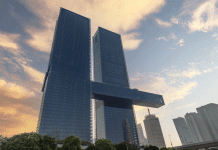The benefits of taking account of weather and climate data at the design stage of a building project extend through the building lifecycle. It can reduce costs, time, energy and effort throughout the life of your asset
A 3D model of an asset is a perfect tool for testing different weather and climate scenarios. You can obtain real-time building performance feedback information and identify and address any weaknesses in your design immediately.
The importance of location
Conditions at your location will have a big impact on the design, construction and operation of your development. Selection criteria varies depending on the nature of the project, but weather and climate will always play a major role. They influence which materials and systems you’ll use and how safe, long or costly the construction phase will be. Future weather will also affect the comfort and energy efficiency of the finished building.
Which weather conditions should you include in your site selection process?
Rainfall: The amount, intensity, duration and frequency of rainfall will help you determine the suitability of a site in relation to localised flooding.
Soil moisture and site runoff: Will inform you about the soil moisture at different times of the year. Among many of its uses, it can help with heavy plant operations, informing drainage and subsidence risk.
Wind: Illustration of wind patterns will help you assess site suitability as to wind direction, mean speed and maximum gusts. It will also help inform the structural plan for the building.
Temperature: Air and ground temperatures, as well as the severity and duration of cold spells and heatwaves, will impact on a building’s viability and future performance.
Snow, frost and freezing: Days of snow and days with snow lying, days of freezing, days of ground frost and days of air frost help with materials selection and planning of the construction phase.
Sunlight: Information about sunlight can help you assess the suitability of your site in relation to cooling, heating and shading.
UK Climate Projections: Due to the long life expectancy of infrastructure, it’s important to consider the future when evaluating locations. A location considered as low risk now may be exposed to extreme weather in 30, 40 or 50 years. With the UK Climate Projections (UKCP18), you can see what effect climate change could have on your site in the long term.
Accurate, location-specific weather and climate information will help you make informed decisions to determine the best possible site for your building within a specific region.
Design for future weather and climate
Changing climate will affect the building industry. Extreme weather, likely to be more impactful in the future according to UKCP, may have a significant effect on building degradation, energy demand and the risk of localised flooding.
“With the increasing demand for more sustainable and energy-efficient buildings and services to combat climate change, weather data has now become an essential component of virtually every new building design and major refurbishment,” – CIBSE.
Market demand for climate resilient, zero-carbon, sustainable buildings is increasing. In the same time buildings that are not resilient for the future are likely to lose value due to poor performance.
It is therefore important for building designers to create models that can cope with the three major challenges: higher temperatures, severe weather and changes in rainfall.
Sustainable cooling and heating
UKCP18 projects a greater chance of hotter, drier summers and warmer, wetter winters.
Hotter summers represent a significant challenge for keeping buildings cool and comfortable. Incorporating weather and climate insights into design plans enables adaptation of designs to meet future cooling demands. Past and projected data (including temperature, humidity levels and hours of sunlight) can help you design efficient cooling and ventilation systems. This information can also guide other decisions, such as the choice of insulation, to reduce heat gain through the building walls.
To help you adapt building design so that people can live and work in comfort in the context of future temperature levels, we’ve teamed up with the Chartered Institute of Building Service Engineers. Through CIBSE, you can access weather data files that will allow you to test your design against different weather and climate scenarios.
Weathertight design
Extreme weather events such as strong winds, storms and floods can cause immense damage to infrastructure. Your building model should, therefore, be weathertight and robust enough to withstand anticipated extremes of weather. With an understanding of the level of exposure that the building will have to deal with, you will be able to adapt materials and construction techniques accordingly.
Managing water
An increased likelihood of summer droughts, extreme rainfall and flooding represents a challenge for the construction industry.
Rainfall and site runoff data can be especially useful in developing sustainable and efficient drainage systems. The information will help designers decide on the sizing of gutters, pipes and surface water drainage so that the system can deal with any increases in rainfall.
Weather and climate data are also important for the effective design of smart rainwater harvesting systems as tank sizes will need to take potential summer droughts and the amount and frequency of rainfall into account.
Finally yet importantly, rainfall data can enable understanding of the risks of localised flash flooding.
Low environmental blueprint
According to UKGBC (UK Green Buildings Council), the built environment contributes around 40% of the UK’s total carbon footprint and there is growing pressure for newly constructed buildings to be more energy efficient. Weather data can inform the design and implementation of green energy systems, helping to reduce electricity use and carbon footprints.
Summary
Implementing weather and climate insights at planning and design stages can help you ensure buildings are designed to be comfortable for people to live and work in, and resilient to extreme conditions such as drought, flood, severe gales, snowfall and storms.
At the Met Office, our goal is to help you make better decisions to stay safe and thrive. We work with you to help you understand your specific risks and use weather and climate data to inform your planning and design.
For further information please contact us at construction@metoffice.gov.uk, or visit our construction page.
Met Office
Tel: 0370 900 0100
www.metoffice.gov.uk/construction
LinkedIn: Met Office
Twitter: @metofficeB2B
Please note: this is a commercial profile.

















